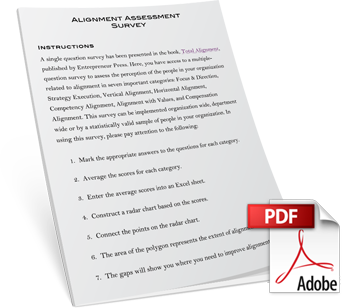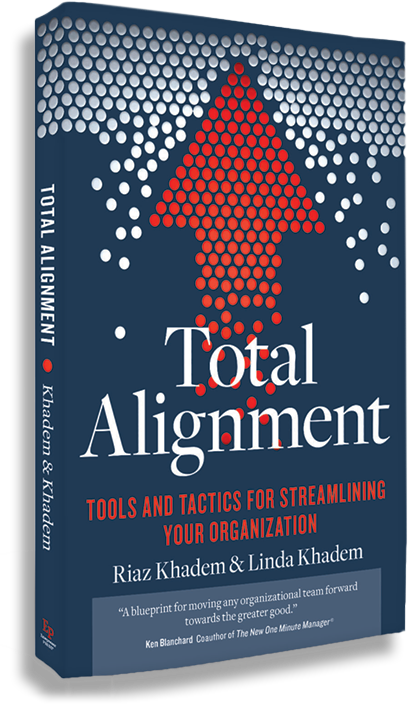Are There Symptoms of Misalignment in Your Company?
- Decision-making takes too long. Slow decision-making decreases the momentum needed for growth and puts your company at a competitive disadvantage.
- Too many meetings. Excessive meetings burden organizations, wasting time and draining productivity.
- Email overload. Highly skilled knowledge workers spend too much time managing emails sent in high volume because organizational responsibilities haven’t been clearly defined.
- Silos. Functional units often become turfs that contain guarded information and interests with a lack of collaboration between departments.
- Unclear responsibility. When responsibilities are not clear, either no one takes charge, the wrong person takes charge, or there is a fight for control.
- Lack of empowerment at lower levels. When people aren’t empowered to act, they wait to receive instructions and progress can be delayed.
- Communication is selective. If information is shared selectively, the truth can be hidden, causing a problem to escalate into a crisis.
- Lack of motivation. Apathy is a serious condition that will have a negative impact on your success.
Test the Current State of Alignment in Your Organization
Use our Alignment Survey to determine the state of alignment in your organization and establish a baseline against which improvements can be measured. Connect with us to dramatically improve your state of alignment and evaluate its success.
Frequently Asked Questions
Even a well-stated mission statement can remain philosophical and elusive. Turning mission into action requires aligned processes. It also requires every collaborator to buy into the mission statement and the processes for delivering it, and to understand how he or she can align with them.
The biggest challenge is not having a creative strategy for turning vision into reality. For those companies that do have the right strategy, their challenge is to align everyone’s actions with that strategy. If people are not aligned, their energies might be spent in other ways that are not congruent, thereby wasting time and resources.
Yes, exactly. What will help them to realize their vision is a creative strategy that must be executed well. Many companies are challenged by strategy execution. It’s about follow-through on the course you have set before you, and adjusting that course based on learning as you move forward.
We started working with companies and helping them to develop metrics to better define job roles and track progress for their employees. We realized that job roles needed to be more directly linked to the overall strategy of the company. To achieve that, we realized that the next step was aligning all of the processes of the organization, including performance, competency, and compensation, with the same strategy so that everyone would be on the same page.
It doesn’t necessarily look different—it’s only a question of scale. The process and principles are the same, but obviously aligning a large organization has a different degree of complexity from a small one.
There are many ways. One unique aspect is improving the productivity of managers. By measuring each manager’s contribution through an individual scorecard, redundancies and unnecessary positions can be eliminated. The byproduct is all managers focused on doing more to advance the company goals.
Some of the unique benefits are: improved strategy execution; a collaborative culture; a common language throughout the organization; transparency about performance; and fair criteria for linking performance to compensation. Additionally, every manager at every level will have a clear sense of best practices to guide them.
Managers at any level can apply principles of total alignment with their direct reports. However, it is very important to have the support and involvement of the CEO for a company to become totally aligned.
Anonymous surveys should be filled out by every manager to assess existing alignment, and to measure progress along the journey toward alignment.
Individual scorecards clarify the added value of each person’s job and measure their success. They provide ongoing feedback on progress for direct reports and clarity of responsibility as well as increased ownership in the company’s success. For the manager they provide a concrete way to align vertically with direct reports. For the company, they ensure that everyone is focused in the same direction— achieving the company’s vision.
Scorecards allow companies to capture each individual’s contribution on a monthly basis, so they can compensate them fairly based on the level of their contribution.
It has a unified purpose, a clear vision, and a strategy aligned with the vision. Individuals are accountable for their contribution to vision and strategy. They have clearly defined responsibilities supported by key information to track their progress. Individual competencies are aligned with their accountabilities. Behaviors are congruent with values. Compensation is linked to performance. Teams at the right levels are empowered to develop and implement action plans to improve results. Cross-functional responsibilities are clearly defined, silos disappear, and problems are resolved jointly across departments. Compensation is linked to performance. An aligned company is a well-oiled machine that achieves its mission and produces results.
We were asked to apply a total alignment system by a newly appointed CEO of FEMSA, currently the largest beverage company in Latin America and the largest Coco Cola bottler in the world. Together with other strategic initiatives, the CEO was successful in increasing revenue 21 times, EBITDA 16 times, and employment 7 times between 1996 and 2016.
Meet with your direct report; ask him/her to identify the top five priorities of his/her job and list them in order of importance. You should also do this separately. Then you can compare the lists and come to an agreement on how to reduce the gap.





